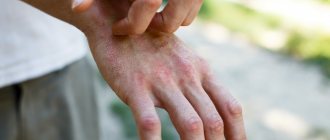Skin xerosis is an abnormal dryness of the upper layer of the skin caused by changes in the hydrolipid balance of the skin. It manifests itself as a dry, rough structure of the surface of the skin. The skin becomes cracked, inflamed, and infected. With the disease, the entire spectrum of pathological skin changes is observed: disturbances in sebum secretion, sweating, skin lipids, amino acid deficiency, and a feeling of discomfort. The condition is constantly accompanied by itching, which reduces the patient’s quality of life.
Causes
The main mechanisms for the development of dryness and flaking of the skin are a violation of its acid-base balance, poor functioning of the sebaceous glands, too frequent renewal of the upper layer of the epidermis and moisture deficiency in the epithelium.
The reasons may be: external influences, various diseases - both dermatological and general, and the general condition of the body. Of the external factors that have an adverse effect on the skin and cause dry skin, the most significant are the following:
- exposure to aggressive substances;
- chapping, hypothermia or overheating of the skin (for example, a sauna);
- improper skin care;
- exposure to ultraviolet radiation, especially in combination with weathering, or prolonged contact with an alkaline environment (for example, staying on the beach by the sea);
- regular exposure to hot or extremely cold water, especially chlorinated water.
Dry and flaky skin can be symptoms of the following diseases: allergic reaction; acquired, hereditary or congenital skin diseases, including psoriasis, seborrhea, eczema, atopic dermatitis, ichthyosis; diseases of bacterial, viral, inflammatory, hereditary and other etiologies. Dry and flaky skin may indicate the presence of: endocrine diseases (hyper- or hypofunction of the thyroid gland or adrenal glands, diabetes mellitus); problems with the digestive tract (gastritis, duodenitis, cholecystitis); metabolic disorders; some neurological ailments (migraine, autonomic-vascular dysfunction, neuralgia, neuroses, depression); damage to the endocrine system and other diseases requiring treatment. The most common cause of the development of xerosis is poor nutrition and, as a result, a lack of minerals and vitamins in the body. Spring peeling of the skin, often mistaken for an allergy, is in fact most often a manifestation of a lack of vitamins in the body. It is dull, dry and flaky skin that in most cases is the first symptom of vitamin deficiency A, E, B1 and C. Interestingly, a deficiency of vitamin B6 manifests itself on the contrary, with oily skin prone to acne formation. Dry hand skin may indicate a lack of vitamins A, E, B7 and D. Dry and flaky skin can also be caused by a lack of minerals (zinc, magnesium) and Omega 3 (polyunsaturated fatty acids).
Treatment for dry skin
Therapy for excessive dry skin will depend on both the location of the lesion and the age of the patient, the presence of concomitant diseases and allergic reactions.
Dry hand skin: causes and treatment
To eliminate dry hands and treat skin, a number of important protective measures must be taken:
- work with aggressive substances only in rubber or cotton gloves;
- in the cold season, wear warm gloves or mittens before going outside;
- lubricate your hands with sunscreen with UV filters;
- dry your hands after washing with a soft towel using blotting movements;
- use good quality household chemicals;
- balance the diet;
- pay attention to the amount of vitamins A, B and E consumed, and if necessary, take a multivitamin complex.
To treat dry hand skin, moisturizing and wound-healing medical creams and ointments are used. As an alternative, you can use folk recipes, including masks, baths and compresses with a wound-healing, moisturizing and nourishing effect on the skin.
Dry skin in a child
One of the causes of dry skin in infants may be a reaction to laundry detergents or clothing that is too stiff. To do this, it is recommended to use specialized powders for children that contain fewer aggressive and dangerous substances. High-quality ironing of all clothes from the wrong side will eliminate the remains of unrinsed detergents and make the surface of the fabric softer and smoother.
At the same time, it is necessary to use special products to moisturize and nourish delicate baby skin: creams, oils and emulsions are applied immediately after bathing, when the skin is cleansed and has absorbed the maximum of nutrients. Up to 3 months, pediatricians recommend using baby oils, regardless of skin condition; these products can be replaced with extra virgin olive oil, which contains only natural ingredients.
If, despite all the measures, the child’s skin remains dry, a consultation with a dermatologist and allergist will be required, who will help determine the cause of the disorder and select the appropriate treatment.
Dry scalp: what to do?
To eliminate dry skin and prevent hair loss, it is necessary to exclude all negative factors: wash your hair with warm water, dry your hair naturally at room temperature, do not comb wet hair. Adjusting your diet with the introduction of fish, vegetable oils and protein foods will help solve the problem of dry scalp. As emergency measures, you can use professional care products or folk recipes for wraps and masks with onions, eggs, oils or milk.
Dry skin on elbows: treatment
To treat dry skin on the elbows, it is necessary to identify and eliminate the internal cause of this disorder, that is, treat the underlying disease. As an auxiliary therapy, symptomatic treatment is used, aimed at improving the exfoliation of dead skin and softening its rough areas. The most popular traditional medicine recipes in this case are compresses made from sour cream with sunflower oil, a scrub made from honey with ground coffee and baths with warm milk.
What to do if very dry skin is peeling
What to do if your facial skin is very dry? First of all, consult a doctor who will conduct a comprehensive examination of the body. The condition of the skin on the face can be affected by factors such as:
- disorders of the gastrointestinal tract;
- diseases of the nervous system;
- diseases of the endocrine system;
- hypovitaminosis (especially lack of vitamins A, E and group B).
In these cases, without treating the underlying disease, careful facial care will only provide a temporary effect. Once you stop using actively moisturizing and nourishing products, your skin condition will worsen dramatically.
Your attending physician will tell you in detail what to do with dry skin, who will determine the true cause of the problem and select the appropriate treatment. It will be useful to follow general recommendations: minimize the aggressive influence of environmental factors and carefully select products for daily care and cleansing.
Traditional medicine offers a number of very effective recipes for masks and washes that will help in the fight against dry skin on the face. Most of them include vegetable oils, herbal infusions, fresh fruits and vegetables, and egg yolk - a source of tons of nutrients.
Dry body skin: treatment
What to do with very dry body skin? To begin with, eliminate possible external negative factors and review your daily diet, paying attention to a sufficient amount of seafood, nuts, dairy, fish, broccoli and vegetable oils.
If following a diet and protecting yourself from external negative factors do not help correct the situation, you will have to consult a dermatologist - most likely, dry skin on the body is caused by one of a number of diseases that need to be diagnosed and treated.
Traditional medicine recipes in the fight against dry skin can only be used after consultation with your doctor. These can be honey peels, baths with a decoction of herbs and seeds, masks and applications of fruits and vegetable oils.
Dry skin on legs: treatment
What to do with dry skin on your feet? In addition to eliminating the cause, use foot creams that contain moisturizing and moisture-retaining components. Among folk recipes, you can use masks with fruits, vegetables or castor oil - the nutrients from them will have a beneficial effect on damaged skin.
Dry skin on the heels can cause quite serious and painful cracks, what to do with such problems? Recipes used to treat similar cracks on the hands are suitable here: compresses with apple cider vinegar or a mixture of glycerin and ammonia.
Symptoms
Most often, dry skin is a temporary problem that only bothers you during a certain season, but it can last a lifetime. Symptoms of xerosis depend on your general health, age, where you live, and how much time you spend outdoors. Possible symptoms include:
- Feeling of tightness of the skin, especially after a bath.
- The skin is wrinkled and dehydrated.
- The skin looks rough instead of smooth.
- The itching is disturbing, sometimes very intense.
- Peeling of the skin - from slight to severe.
- Cracks in the skin, sometimes bleeding and painful.
- Redness of the skin, usually in limited areas.
Symptoms of dry skin
Symptoms of dry skin are specific and similar in different parts of the body:
- feeling of tightness;
- rough surface;
- excessive smoothness and shine;
- possible itching of the affected areas, redness;
- in some cases - cracking and bleeding, the appearance of small wounds covered with crusts.
If you notice similar symptoms, consult a doctor immediately. It is easier to prevent a disease than to deal with the consequences.
Treatment
Methods for moisturizing the skin are different and are largely determined by eliminating the source - the catalyst of the problem. If the cause is a specific disease, then treatment of dry skin of the body includes all the necessary measures that can stop the pathology, and hence remove its accompanying symptoms.
If the reason is different, then it is necessary to take measures to protect the skin from the negative influence of external irritants, which can be eliminated independently. It is necessary to keep the skin clean, but you should not overdo it with the amount of washing and taking baths and showers. Cosmetics for washing must be of high quality and match your skin type. You should use only high-quality, non-expired cosmetics. In winter, it is necessary to use protective creams. In everyday life, prefer clothes and shoes made from natural materials. This will protect against the occurrence of allergic reactions to artificial material and protect against thermal overheating of the skin. Anti-inflammatory agents must be used along with moisturizers. It is recommended to use anti-allergy medications or general health-improving medications internally, which will be prescribed by your dermatologist.
Danger
If dry skin is not given timely attention, the consequences can be very different. In some cases, the disease may not progress, but in most patients, sooner or later, dry skin begins to itch, crack and become inflamed. The danger of these situations is:
- risk of infection of cracks and development of inflammatory processes;
- risk of increasing the affected skin area;
- the risk of developing complications of the underlying disease if dry skin is a symptom of another disorder;
- constant discomfort of the patient from a feeling of tightness and itching.
Hand massage
The most affordable thing that can be done for care is a hand massage. It will provide the following effects:
- eliminates swelling;
- improves blood circulation;
- softens the skin.
Such procedures are especially indicated when there is a feeling of cold in the hands and in the warm season. After applying the cream, you should move very gently, without pressing, in a circle from the ends of your fingers to your wrist. Massage until the cream stops slipping under your fingers.
Hand care is an important part of a woman’s life, and today also a man’s. If you follow the simple recommendations of cosmetologists, your skin will remain young and beautiful for much longer.
Calcium and vitamin D
Consuming enough calcium and vitamin D is important for maintaining strong bones.
Vitamin D helps the body absorb calcium. If you don't get enough of these vitamins, over time your bones become thin and brittle (osteoporosis).
vitamin D. Also, a lack of the necessary elements can cause muscle spasms, cramps, discomfort and pain in the feet.2
Besides being good for your bones, calcium and vitamin D are also good for your skin.
Calcium in the epidermis (outer layer of skin) helps the body determine how quickly new skin cells are created to replace old ones. Thin, dry, and hard skin may appear on the legs if there is a lack of calcium in the body.3
If you are still faced with the problem of rough skin on your feet, then try making softening foot baths. After the procedure, use a Scholl electric file to remove rough skin and calluses. Don't forget to also apply cream to soften your feet.
Where are calcium and vitamin D found?
- Calcium is found in foods such as milk, cheese, and yogurt.4 Yogurt is often high in calcium and vitamin D. Calcium can also be found in vegetables (such as broccoli), grains, and fruits. Manufacturers add additional calcium to some products, so always check the label (for example, corn flake breakfast cereals).4
- Vitamin D is found in fish: especially salmon, tuna and sardines. You can also get calcium from egg yolk and beef liver, but in smaller quantities.4
How to care for dry skin on the face, legs, arms and body in winter: a few general recommendations
So, we have dealt with the main causes of the problem, now it is time to summarize and derive several rules that are mandatory for everyone.
To ensure that your skin always looks great, is soft and soft, you need to:
- Drink at least 1.5 liters of fresh water daily. Tea, coffee, juices and compotes do not count.
- Always wash your face only with water at room temperature.
- Forget about using alcohol-containing lotions, shower gels and shampoos.
- Regularly humidify the indoor air.
- Wear clothes made from natural fabrics and always protect your hands and head from frost.
- Regularly use natural cosmetics and do simple procedures at home. I will cover this point in more detail.
Folk remedies for treating dry skin on hands and feet
Products from the refrigerator help if the cause of dryness lies in external factors and is leveled by restoring the fatty film. Write down effective recipes:
- wash your hands and feet with warm water without soap. Soak thick disposable wipes in sunflower oil and wrap your limbs. Remove after an hour, dry with a towel, but do not rinse. Do the procedure at night every day for a month;
- Boil two potatoes and grind in a blender. Add 2 drops of olive oil and lemon juice. It will whiten spots on the skin of your hands and feet. Apply a thick layer to dry areas and wrap with gauze. Rinse off after 20 minutes, lubricate with cream;
- Buy coltsfoot leaves at the pharmacy, brew, strain the juice. Mix it with equal amount of milk. The solution can be prepared for several days. Lubricate problem areas every time you get ready to leave the house. It is not necessary to apply cream on top;
- before the start of winter, lubricate your hands and feet with olive oil: this will prevent peeling;
- Apply warmed honey to the skin of your hands and feet. To avoid getting dirty, wrap it in plastic. After 10–15 minutes, rinse off. Honey removes redness and saturates the skin with nutrients and moisture.
Prevention
To prevent dry skin, it is necessary to eliminate or reduce the impact of possible negative factors:
- wear hats to protect the scalp from drying out;
- use sunscreen not only on the beach, but also while walking outdoors in the city or on a picnic;
- regularly use moisturizing creams designed for a specific skin type;
- Wash children's underwear with hypoallergenic detergents and rinse thoroughly;
- undergo regular preventive examinations for timely diagnosis of diseases affecting the condition of the skin.
This article is posted for educational purposes only and does not constitute scientific material or professional medical advice.
The main causes of dry skin on the body, arms, legs and face
Before you begin developing a care program, you need to determine the cause of dryness. This approach will allow you to properly concentrate your strength, find the most effective remedy and regain your beauty and comfort in the shortest possible time.
- Temperature changes
In winter, the air outside is cold, and the air indoors is too hot and lacks humidity due to the heating being on. That is why every time you return home from the street, your skin suffers from loss of moisture and disruption of the natural water balance. This is why you feel tightness and burning. You can help yourself in this situation. I recommend following simple rules: regularly humidify the air in the room, wear a hat and gloves when you go out for a walk, and be sure to apply nourishing cream to your hands and face 40 minutes before leaving the house.
- Hot shower and bath
Many of us use hot water to warm ourselves up, but this is not recommended. Sitting for an hour in a hot bath or standing under a scalding shower is dangerous for the surface of the epithelium. This way you destroy the natural lipid layer and provoke dryness and flaking. To solve this problem, I advise using only warm water, bathing and showering for no more than 15 minutes. And immediately after water procedures, lightly walk over the body with a soft towel and apply moisturizing milk.
- Dehydration
In the summer, when the heat makes it difficult to breathe and you want to sit in the shade, we regularly consume large amounts of liquid to cool down and quench our thirst. In winter everything is different. We suffer from frost and wind, preferring hearty meals to drinks. As a result, without noticing it, we deprive our body of the water it needs. The skin is the first to signal such a deficiency. Itching, dryness, tightness and flaking - every girl who drinks less than 7-8 glasses of regular non-carbonated water per day faces all this. To avoid dehydration, I recommend following a simple rule. Get into a healthy habit and drink at least 1.5 liters of fresh water regularly.
- A large number of clothes
What do we do when we feel it getting colder? Right. We wear a lot of clothes. The more we wear, the more the surface of our body rubs. This is especially true for the legs. Stockings, tights, gaiters and socks - all this together not only rubs, but also interferes with normal blood circulation, microcirculation in the veins and vessels is disrupted, and this entails not only peeling and itching, but also a more serious problem - varicose veins. In addition, woolen products can also cause irritation and even allergies.
What to do in severe frosts, how to not freeze, but also not harm yourself? I advise you to pay very close attention to the choice of materials for your winter clothing, so that later you won’t be surprised why, with proper care, the skin is still dry and often itches unpleasantly. Give preference to natural fabrics, such as linen or cotton. Also, choose loose styles to keep you warm and avoid excessive sweating. Save tight outfits for the summer, and in winter, think about maintaining your health and beauty.
- Excessive cleansing
I already said that taking a bath and shower for too long can be harmful, but now I’ll note another important nuance. Not only the temperature of the water in which you wash is of great importance, but also what kind of cleanser you use. Often the use of shampoos, soaps, shower gels that contain alcohol or a large amount of chemical fragrances harms the condition of your skin, making it dry and dull. As a solution to this problem, I suggest purchasing natural skincare cosmetics that do not contain alcohol, but contain many oils and natural ingredients.











